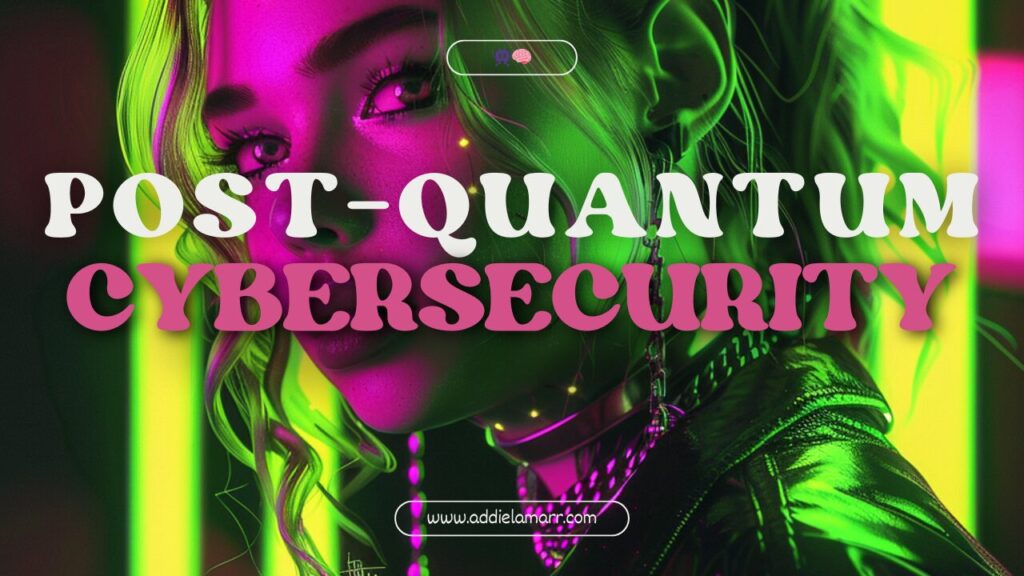Quantum computing is no longer a far-off concept—it’s making headlines, and organizations are understandably anxious. When Google’s quantum computer pops up in the news, it can feel like your encryption is seconds away from being rendered useless. If you’re a cybersecurity professional, it’s your job to guide your organization through the noise, calm the panic, and start laying the groundwork for a quantum-secure future.
Here’s everything you need to know about quantum threats, what steps to take now, and how to future-proof your organization’s security against this emerging challenge.
Why Quantum Computers Pose a Threat

To grasp the quantum threat, it helps to understand the mechanics of modern encryption and why certain algorithms are vulnerable. Cryptography today relies on math problems that are easy to compute in one direction but extremely hard to reverse—at least for classical computers. Quantum computers, however, operate on entirely different principles, allowing them to solve these problems exponentially faster.
How Classical Encryption Works
- Public-Key Cryptography (Asymmetric Encryption):
Algorithms like RSA, ECC (Elliptic Curve Cryptography), and Diffie-Hellman underpin most internet security. They rely on “trapdoor functions”—math problems that are easy to compute in one direction but prohibitively hard to reverse. For example:- RSA: Based on factoring the product of two large prime numbers. Breaking it requires factoring this product, which is computationally infeasible for classical computers when the primes are sufficiently large.
- ECC: Built on the difficulty of solving the elliptic curve discrete logarithm problem.
- Diffie-Hellman: Relies on the difficulty of solving the discrete logarithm problem.
- Symmetric Encryption:
Algorithms like AES (Advanced Encryption Standard) use the same key for encrypting and decrypting data. Their strength lies in key size and computational complexity. Unlike asymmetric encryption, symmetric algorithms are less vulnerable to quantum attacks.
How Quantum Computers Change the Game

Quantum computers leverage quantum bits (qubits) that can exist in multiple states simultaneously, thanks to superposition. They also exploit entanglement, which allows qubits to be correlated in ways classical bits cannot. These features enable quantum computers to process vast amounts of information in parallel, tackling certain problems exponentially faster than classical computers.
Grover’s Algorithm:
While less dramatic than Shor’s, Grover’s Algorithm allows quantum computers to search unsorted data (e.g., brute-forcing a symmetric encryption key) in square root time. For example, it effectively reduces the strength of an AES-128 key to AES-64. Doubling the key length (e.g., AES-256) neutralizes this threat.
Shor’s Algorithm:
This quantum algorithm specifically targets the kind of math that makes RSA, ECC, and Diffie-Hellman secure. It can factor large numbers and solve discrete logarithms in polynomial time—a feat that would take classical computers an infeasible amount of time to achieve. A sufficiently powerful quantum computer running Shor’s Algorithm could decrypt data protected by these algorithms.
What’s at risk?
Anything that relies on these algorithms:
- HTTPS traffic
- VPNs and secure email
- Digital signatures used in software updates
- Cryptocurrency wallets and blockchain technologies
What’s NOT at risk?
Symmetric encryption (like AES) and hash functions (like SHA-3) are less vulnerable. While Grover’s Algorithm can theoretically speed up brute-forcing symmetric keys, doubling the key length (e.g., from 128-bit to 256-bit) makes them safe even against quantum attacks.
Why You Shouldn’t Panic

The headlines about quantum computers may sound alarming, but there’s no need to panic. Here’s why:
1. Quantum Computers Aren’t There Yet
While quantum computers are advancing rapidly, the kind of machine needed to break modern encryption—capable of running Shor’s algorithm at scale—does not exist. Even Google’s latest quantum computer, which made waves recently, is not remotely close to this capability. Current quantum systems are impressive in the lab but lack the stability and scale to pose a practical threat to encryption used in the real world.
2. Post-Quantum Cryptography Is Ready to Go
NIST has been working behind the scenes for years, preparing for this moment. The agency has finalized post-quantum cryptography standards, providing robust, quantum-resistant algorithms that are ready for integration:
- FIPS 203: Module-Lattice-Based Key-Encapsulation Mechanism Standard (derived from the CRYSTALS-Kyber submission).
- FIPS 204: Module-Lattice-Based Digital Signature Standard (derived from the CRYSTALS-Dilithium submission).
- FIPS 205: Stateless Hash-Based Digital Signature Standard (derived from the SPHINCS+ submission).
These algorithms weren’t just picked at random—they were rigorously vetted and stress-tested against a range of quantum and classical attacks. Vendors and developers are already incorporating these standards into tools and systems, so the solutions are well on their way to mainstream adoption.
3. Your Data Is Safe—for Now
Quantum threats target cryptographic algorithms, but that doesn’t mean everything is at risk. Symmetric encryption methods like AES and hash functions like SHA-3 are much less vulnerable to quantum attacks. In many cases, simply increasing key sizes (e.g., AES-256 instead of AES-128) is enough to ensure resilience.
4. The Timeline Is on Your Side
Even if quantum computers capable of breaking encryption were to become feasible, it would take years to build and deploy them on a meaningful scale. This gives organizations ample time to implement post-quantum cryptography and update their systems. NIST’s standards are here well before the threat materializes, giving us a critical head start.
5. Preparation Beats Panic
The quantum threat is manageable because we know it’s coming. Unlike many cybersecurity challenges, which can blindside organizations, quantum risks are a slow-moving wave. You have the opportunity to prepare systematically—starting with understanding the risks, conducting a cryptographic inventory, and planning a transition to quantum-resistant standards.
Bottom Line
Quantum computing is an exciting technological leap, not an existential crisis for the internet. The tools to address quantum risks are already here, and the timeline gives you plenty of breathing room to adapt. By acting proactively and staying informed, you can ensure that your systems are secure—both today and in the quantum future.
Steps to Protect Your Organization

1. Conduct a Cryptographic Inventory
Start by mapping out where and how cryptography is used across your organization. Look at:
- Websites, APIs, and email systems
- Internal and external VPNs
- Third-party services that handle sensitive data
- IoT devices and embedded systems
- Certificates used for digital signatures
This inventory will help you identify which systems rely on vulnerable algorithms like RSA or ECC.
2. Assess the Sensitivity of Your Data
Not all data needs the same level of protection. Classify your data based on its sensitivity and shelf life. For example:
- Short-term data (e.g., daily operational information): Less urgent.
- Long-term data (e.g., medical records, financial data): High priority.
Sensitive data with a long shelf life should be a top focus for post-quantum migration, as it could be intercepted now and decrypted later when quantum computers mature.
3. Monitor Post-Quantum Standards and Tools
Keep up with NIST’s post-quantum cryptography standards and look for software updates from your vendors. Many organizations and open-source communities will start releasing quantum-resistant solutions in the coming years. Your job is to stay informed and adopt tools as they become available.
4. Adopt a Crypto-Agile Approach
Crypto agility means designing systems that can easily switch out cryptographic algorithms without major overhauls. For example:
- Use libraries and protocols that support modular cryptography (e.g., OpenSSL with configurable ciphers).
- Avoid hardcoding specific algorithms into your systems.
This flexibility will make transitioning to post-quantum algorithms smoother.
5. Strengthen Symmetric Encryption Now
Symmetric algorithms like AES will remain resilient with larger keys. Update your systems to use AES-256 wherever possible.
6. Implement Zero Trust Architecture
Quantum security is about more than encryption—it’s about building a robust security framework. Zero Trust principles can help:
- Verify everything: Continuously authenticate and authorize users, devices, and systems.
- Least privilege: Limit access to the minimum required.
- Segmentation: Break your network into smaller zones to contain potential breaches.
Zero Trust ensures that even if encryption is compromised, attackers can’t move freely through your network.
7. Plan for Post-Quantum Migration
Develop a roadmap for transitioning to post-quantum cryptography. This should include:
- Prioritizing systems with the most sensitive data.
- Testing new algorithms in controlled environments.
- Phasing in updates to avoid downtime or disruptions.
8. Educate and Collaborate
Your stakeholders (and your team) need to understand what’s at stake and what steps you’re taking. Regularly communicate about quantum threats and progress on your post-quantum strategy.
How Zero Trust and Quantum Resistance Work Together

The rise of quantum computing highlights the need for a layered approach to security. Even the strongest encryption won’t protect you if the systems surrounding it are vulnerable. That’s where Zero Trust comes in. While Zero Trust doesn’t directly prevent quantum threats, it complements post-quantum cryptography in meaningful ways, enhancing your organization’s overall security posture.
Why Zero Trust Matters in a Post-Quantum World
- Reducing the Attack Surface:
Zero Trust operates on a “never trust, always verify” principle, requiring strict authentication and continuously validating access requests. This reduces the opportunities for attackers to exploit vulnerabilities or escalate privileges, even if they compromise encrypted data. - Minimizing Impact:
By implementing segmentation and least-privilege access, Zero Trust ensures that attackers can’t move laterally within your network. If encryption is breached—whether by traditional or quantum means—Zero Trust contains the damage to a single segment, limiting the blast radius. - Enhancing Software Supply Chain Security:
Compromised digital signatures are a potential quantum threat, but Zero Trust principles help mitigate supply chain risks. For example, enforcing strong identity verification and monitoring software updates can detect and block malicious changes before they propagate.
How Zero Trust Complements Post-Quantum Cryptography
Post-quantum cryptography focuses on safeguarding encrypted data against quantum-enabled decryption. Zero Trust, on the other hand, provides a framework to protect the entire ecosystem around that data. Think of it like this: post-quantum cryptography is the high-security gate that quantum computers will have a hard time breaking through. Zero Trust adds “blast-proof doors” throughout the building, ensuring that even if someone gets past the gate, their movements are restricted and heavily monitored.
Zero Trust Is Your Security Blanket
While transitioning to quantum-resistant cryptography, Zero Trust provides an extra layer of defense to keep your systems secure. Its principles of continuous authentication, segmentation, and least-privilege access reduce the chances of quantum threats—and other types of attacks—causing significant harm.
The combination of post-quantum cryptography and Zero Trust doesn’t just address the risks of quantum computing; it creates a resilient, defense-in-depth security model that’s ready for whatever the future holds.
The Clock Is Ticking—But You’ve Got Time

Quantum threats aren’t hypothetical anymore, but they’re not imminent either. The organizations that prepare now will be the ones that thrive when quantum computing matures. Your action plan boils down to this:
- Understand your risk. Inventory systems and prioritize sensitive data.
- Watch the horizon. Follow NIST’s standards and vendor updates.
- Start migrating. Transition to crypto-agile systems and post-quantum standards.
- Fortify your defenses. Strengthen symmetric encryption and adopt Zero Trust.
Quantum computing isn’t a reason to panic—it’s a reason to get proactive. The future of cybersecurity is quantum-resistant, and with the right steps today, you’ll be ready for whatever tomorrow brings.
Need Help With Your Post-Quantum Transition?
If your company is navigating the complexities of post-quantum migration, I’d be glad to help. With a deep expertise in cryptography and a passion for post-quantum solutions, I can provide tailored guidance to ensure your transition is both seamless and secure. Connect with me on LinkedIn to explore how I can assist your organization in staying ahead of quantum threats.



